A few solutions were tested with different indicators and results were noted down in the given table.
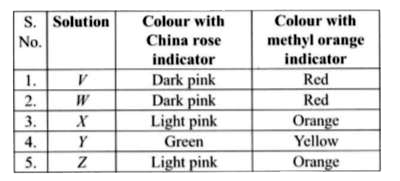
Study the given table carefully and fill in the blanks by choosing an appropriate option.
Solution(s) (i)––– will have no effect on blue litmus paper while solution(s) (ii)–––– will turn blue litmus red. Phenolphthalein remains colourless in solution(s) (iii)––––– while it changes to pink colour in solution(s) (iv)––––.

i- X,Y ii-V iii- W,Z iv-Z
i- X,Y,Z ii-V,W iii- V,W,X,Z iv-Y
i- V,W,X,Z ii-V,W iii- Y iv-X,Y,Z
i- X,Y,Z ii-V,W iii- V,W iv-Y,Z
The correct Answer is:B

Hence, solutions X, Y and Z will have no effect on blue litmus paper, solutions V and W will turn blue litmus paper red. Phenolphthalein remains colourless in solutions V, W, X and Z while it changes to pink in solution Y.
Topper's Solved these Questions
Similar Questions
A few reactions are listed below:
I. Hydrogen + Oxygen → Water II. Calcium oxide + Carbon dioxide → Calcium carbonate III. Silver nitrate + Copper → Copper nitrate + Silver IV. Sodium hydroxide + Hydrochloric acid → Sodium chloride + Water V. Sodium nitrate → Sodium nitrite + Oxygen
Now, read the given passage and fill in the blanks by selecting an appropriate option. Reaction(s) ___(i) is/are combination reaction(s), reaction(s) ____(ii) is/are single displacement reaction(s), while reaction____(iii) is a decomposition reaction. Reaction(s)____ (iv) is/are neutralisation reaction(s) and heat energy is ____(v) in this/these reaction(s).
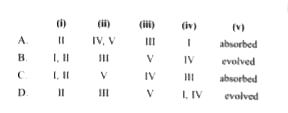 View Solution
View SolutionRead the given passage and fill in the blanks by choosing an appropriate option.
When a mixture of two (i) –––––––– liquids having a difference of 25∘C in their boiling points is to be separated, a (ii) –––––––– is used which increases the (iii) ––––––––– surface area. As a result, when the vapours of both the liquids rise, the (iv) –––––––––– volatile liquid will condense while the vapours of (v) –––––––– volatile liquid will rise.
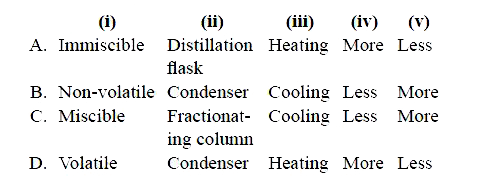 View Solution
View Solution
Knowledge Check
- Question 1 - Select One
Read the given passage and fill in the blanks by selecting an appropriate option. Bleaching powder is a (i) –––––– powder. When exposed to air, it reacts with (ii) ––––––– of the air to liberate Cl2 gas. It is (iii) –––––––– in cold water and milkiness of the solution is due to presence of unreacted (iv) ––––––––. It reacts with HCl and H2SO4 liberating (v) ––––––– gas.
 AABBCCDD
AABBCCDD - Question 2 - Select One
Study the given statements and select the correct answer.
(i) Cellulose is a homospolymer of glucose.
(ii) Inulin is a homopolymer of fructose.
(iii) Starch gives blue colour and glycogen gives red colour with iodine solution.
(iv) Cellulose gives no colour with iodine solution.AStatements (i), (ii) and (iii) are correct.BStatements (i),(ii) and (iv) are correct.CStatements (ii) and (iii) are correct.DAll statements are correct. - Question 3 - Select One
For students A,B,C and D were studying the effect of the solutions of hydrochloric acid, sodium hydroxide, sodium chloride and pure water respectively on the blue litmus solutioin. Which of the students observed the colour change of blue litmus solution to red?
AABBCCDD
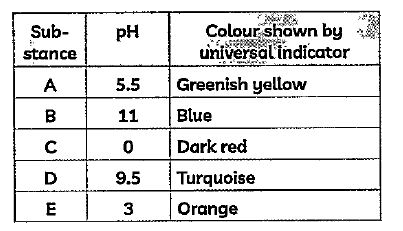
Which of the following properties are shown by solution B?
(I) It is the strongest base among the given substance.
(II) It is used in antacids.
(III) It turns litmus paper to blue.View SolutionA group of students looked at different metals and metal sulphate solutions given in a tabular form. From the data answer the following :
(i) Which metal reacted with all other metal sulphate solutions ?
(ii) Which metal did not react with any other metal sulphate solution ?
(iii) Put the metals in decreasing order of reactivity.
(iv) Iron is slightly more reactive than cobalt. With which other metal sulphate solution, will it react ?
MetalMetal sulphate solutionColourChromiumChromium sulphategreenCobaltCobalt sulphatepinkCopperCopper sulphateblueMagnesiumMagnesium sulphateColourlessView SolutionAnkita tested the solubility of four different substances (I-IV) at different temperatures and collected the data as given in the table.

Fill in the blanks by selecting the correct option. __(x)___ of substance III would be needed to produce a saturated solution of it in 50 grams of water at 40∘C. ___(y)___ has the highest solubility at 20∘C while ___(z)___ has the least solubility at 10∘C.
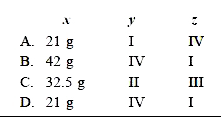 View Solution
View SolutionThe gases 'G' having suffocating odour are obtained when a green solid 'S' is heated, along with a residue 'R' . These gases are major air pollutants . When the vapours of the gases are collected and dissolved in water, the solution turns blue litmus to red . The colour of the residue becomes red
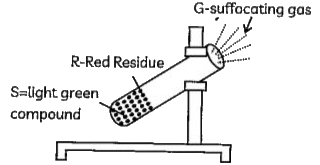
What would be S, R, GView SolutionRead the given passage and fill in the blanks by choosing an appropriate option. When a mixture of two_(i)___ liquids having a difference of 25∘C in their boiling points is to be separated, a _(ii)____ is used which increases the ___(iii)___ surface area. As a result, when the vapours of both the liquids rise, the ___(iv)_volatile liquid will condense while the vapours of_(v)__ volatile liquid will rise.
View Solution

